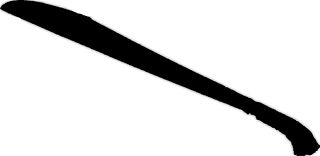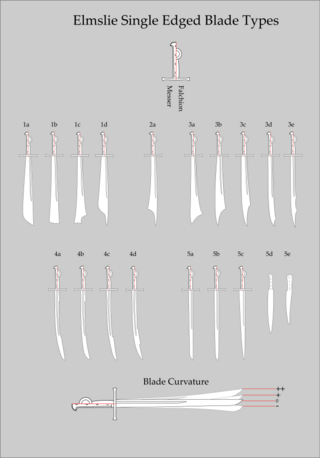
The talwar, also spelled talwaar and tulwar, is a type of curved sword or sabre from the Indian subcontinent.

A kalis is a type of Philippine sword. The kalis has a double-edged blade, which is commonly straight from the tip but wavy near the handle. Kalis exists in several variants, either with a fully straight or fully wavy blade. It is similar to the Javanese keris, but differs in that the kalis is a sword, not a dagger. It is much larger than the keris and has a straight or slightly curved hilt, making it a primarily heavy slashing weapon.

The gothic hilted swords were a family of swords carried by officers and some NCOs of the British Army between 1822 and the present day. They were primarily infantry swords, although they were also regulation pattern for some other officers such as surgeons and staff officers. The term "Gothic hilt" is derived from a perceived similarity between the curved bars of the guard and the arches found in Gothic architecture. They were elegant aesthetically pleasing weapons, although they were considered by some to be mediocre fighting swords. The weapon and its variants had a very long service life.

Dha is the Burmese word for "knife" and "sword" similar term to daab or darb in Thai language for a single edge sword. The term dha is conventionally used to refer to a wide variety of knives and swords used by many people across Mainland Southeast Asia, especially present-day Myanmar (Burma), Thailand, Laos, Cambodia, and Vietnam.

The dahong palay, literally "rice leaf" in Tagalog, is a single-edged sword from the southern Tagalog provinces of the Philippines. It was originally used by farmers to clear thick grass growth. However, during the Philippine revolution of 1896, farmers from Batangas soon came to favor it for its "slashing and thrusting" feel.

This is the glossary of Japanese swords, including major terms the casual reader might find useful in understanding articles on Japanese swords. Within definitions, words set in boldface are defined elsewhere in the glossary.

Niabor is a curved sword from Borneo, a characteristic weapon of the Sea-Dayaks.

Jimpul is a traditional weapon of the Sea Dayak and Kenyah people from Borneo. It is often thought that the Parang Jimpul may be considered as a hybrid between the Mandau and Langgai Tinggang. The Parang Jimpul is an intermediary form between the Mandau and the Langgai Tinggang dating from c. 1870-c. 1885.

Parang Nabur is a sword that originates from Banjarmasin, South Kalimantan, Indonesia. Most of these swords were made during the Banjarmasin Sultanate period in the 19th century.

Balato is a sword that originates from Nias, an island off the west coast of North Sumatra, Indonesia.

The bangkung or bangkon, is a short sword originating in the Sulu Archipelago of the Philippines. The bangkung was used primarily by the Moro people of the Sulu and is not associated with Moros in other areas such as Mindanao, although it is sometimes found in coastal regions. The bangkung is a slashing weapon, meant to deliver hacking type blows. While the bangkung is a very effective sword, it was not popular unlike the panabas and the pirah and for this reason it is one of the most rarely found Moro edged weapons. Few were produced and even fewer survive.

The Moso is a sword found throughout the Alor Archipelago up to Sulawesi, Indonesia.

The Piso Sanalenggam is a type of broad sabre from North Sumatra, Indonesia. This sword is a weapon of war during the times when feuds were frequent among the different Batak groups. Piso Sanalenggam that were made by datu priests from the Dairi Regency region, is used for the preparation of medicine and magical substances.

The Parang Ginah is a sickle shaped Malay cutting implement, whether a sword or a sickle is uncertain, most likely the latter.

Hemola or Hemala is a traditional sword of the Savu people from Indonesia. It is also called Tafa by the neighboring Rotenese people.

The Elmslie Typology is a system for classification and description of the single edged european bladed weapons of the late medieval and early baroque period, from around 1100 to 1550. It is designed to provide classification terminology for archaeological finds of single-edged arms, as well as visual depictions in art. It includes swords which are from the Europeans Middle Ages and currently breaks them down into five main types, which each have several subtypes. Historian and bladesmith James Elmslie introduced the typology 2015, as a complement to the Oakeshott typology which covers double edged swords of the same periods.

Rugi is a traditional sword originating from Wetar and Alor Island, Indonesia. It is also referred to as Rugi Glamang.

Tumbok Lada or Tumbuk Lada is a traditional slightly curved dagger that originates in the eastern coast of Sumatra, Indonesia but also found in the western coast of Malay Peninsula, Malaysia.
The Cot Jang is a sword from Aceh and North Sumatra, Indonesia.

The Ladieng is a sword from Sumatra, Indonesia. It is also commonly known as Parang Lading in Malaysia.
























